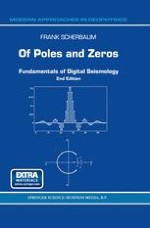2001 | OriginalPaper | Buchkapitel
Inverse and simulation filtering of digital seismograms
verfasst von : Frank Scherbaum
Erschienen in: Of Poles and Zeros
Verlag: Springer Netherlands
Enthalten in: Professional Book Archive
Aktivieren Sie unsere intelligente Suche, um passende Fachinhalte oder Patente zu finden.
Wählen Sie Textabschnitte aus um mit Künstlicher Intelligenz passenden Patente zu finden. powered by
Markieren Sie Textabschnitte, um KI-gestützt weitere passende Inhalte zu finden. powered by
We have now looked at all the essential building blocks of modern seismic recording systems (cf. Fig. 6.19) and seen how they affect recorded seismic signals. We have learned to model the individual components (seismometer, ADC, etc.) using the concepts of continuous and discrete linear time invariant systems (transfer function, frequency response function, impulse response function) and how their interactions can be described by convolution in both the time and frequency domains (convolution theorem). We have become acquainted with the elegant and powerful concept of poles and zeros and learned what they can tell us about important system properties such as minimum phase, maximum phase, etc. In addition, we have seen how we can use poles and zeros to design simple, special-purpose digital filters. After reviewing the theoretical background of the Fourier-, Laplace-, and z-transforms, we have taken a detailed look at the digital antialias filter. We have seen how we can cure the precursory ringing problem of high frequency signals and discussed the design and implementation of a recursive correction filter.
